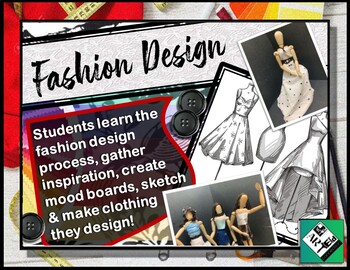Fashion Design: Gather inspiration, create mood boards, sketch and make clothes!
Art Ed Connection
596 Followers
Grade Levels
4th - 12th, Higher Education, Adult Education, Homeschool
Subjects
Resource Type
Standards
CCSSMP4
Formats Included
- PPTX
Pages
23 pages
Art Ed Connection
596 Followers
What educators are saying
This is a fun way to teach students about Fashion design and to allow them to use their own imagination to create mood boards and other materials.
Very thoughtful, well-organized activity. Provides enough detail for teacher and students to engage in.
Description
Fashion Design: Gather inspiration, create mood boards, sketch and make clothes!
This resource walks students through the basic fashion design process. Students will gather inspiration, create mood boards, refine their collection, create sketches and finally create small scale tangible garments based on their process and sketches.
Lesson Includes:
-Intro presentation
-Printable resources
-Video segments
-Full lesson plan, materials list & rubric
-Student product examples
Lesson Duration:
Duration: Approximately 1-2 weeks (5-10 40-50 minute class sessions. (Duration will vary depending on class size and student population)
Grade Level:
Grades 5th-12th
Be the first to here about our new resources, SALES, and giveaways! Sign up for our e-update.
Total Pages
23 pages
Answer Key
N/A
Teaching Duration
2 Weeks
Report this resource to TPT
Reported resources will be reviewed by our team. Report this resource to let us know if this resource violates TPT’s content guidelines.
Standards
to see state-specific standards (only available in the US).
CCSSMP4
Model with mathematics. Mathematically proficient students can apply the mathematics they know to solve problems arising in everyday life, society, and the workplace. In early grades, this might be as simple as writing an addition equation to describe a situation. In middle grades, a student might apply proportional reasoning to plan a school event or analyze a problem in the community. By high school, a student might use geometry to solve a design problem or use a function to describe how one quantity of interest depends on another. Mathematically proficient students who can apply what they know are comfortable making assumptions and approximations to simplify a complicated situation, realizing that these may need revision later. They are able to identify important quantities in a practical situation and map their relationships using such tools as diagrams, two-way tables, graphs, flowcharts and formulas. They can analyze those relationships mathematically to draw conclusions. They routinely interpret their mathematical results in the context of the situation and reflect on whether the results make sense, possibly improving the model if it has not served its purpose.





